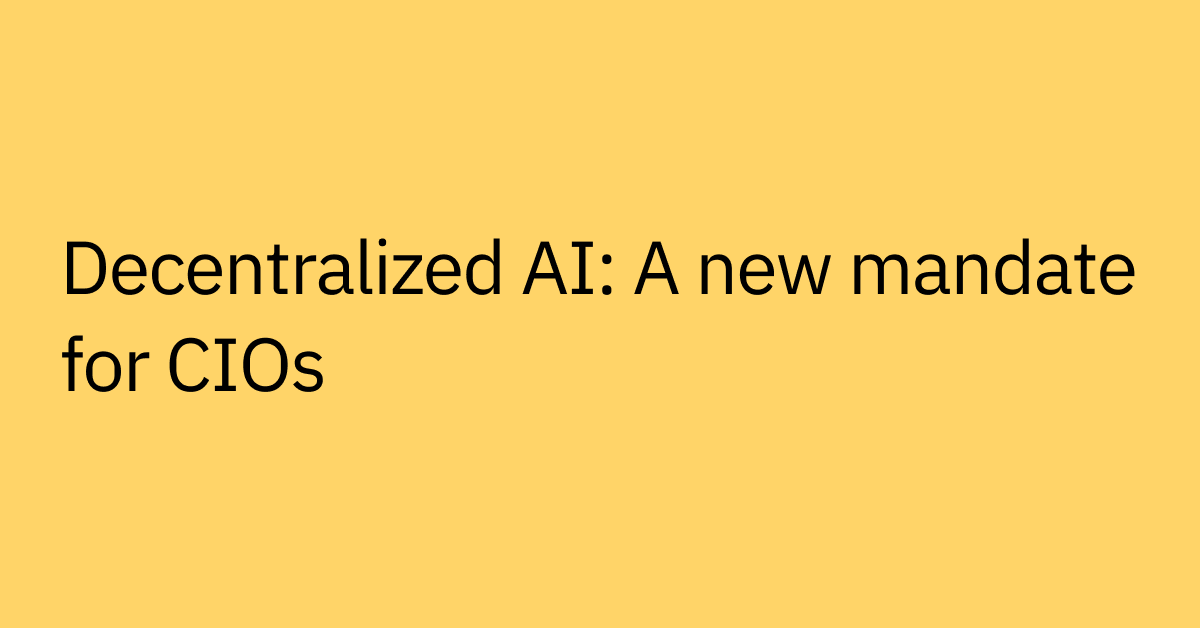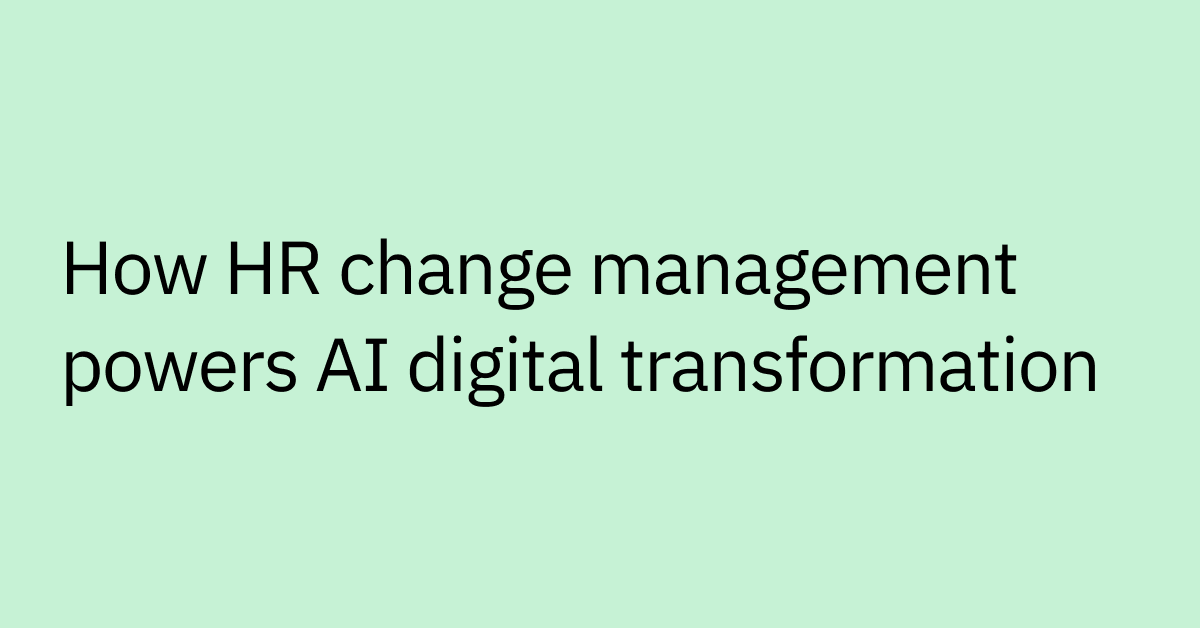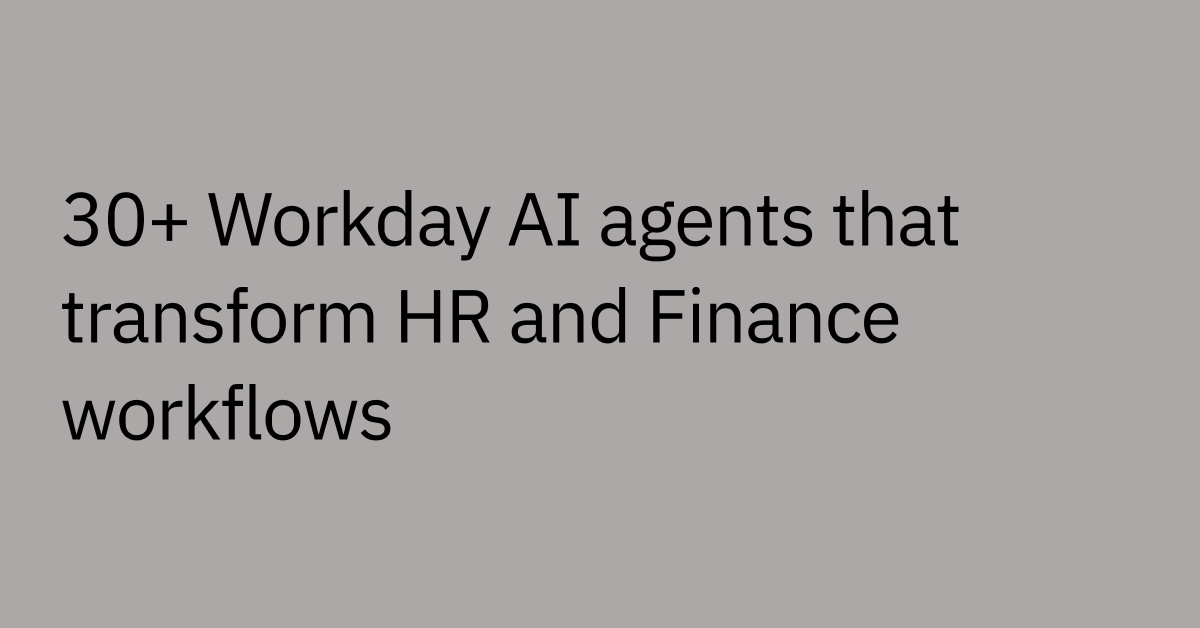Table of contents
Missed our last post?
We explored how to Unleash AI Across Every Corner of the Enterprise, and now we're going deeper. This month, we're focusing on Ambient agents: the next evolution in proactive, always-on automation.
Much of enterprise automation has been a reactive game. We've built powerful systems that respond to our clicks, queries, and explicit commands.
Yet across every department, crucial steps still get missed. A new hire's laptop isn’t provisioned on time. An IT ticket stalls. An approval bottleneck. Why? Because someone had to notice and act.
This is the hidden cost of reactive AI agent automation: lost time, lost momentum, and constant human oversight.
It’s time for a shift — from reactive to proactive. From prompt-based agents to ambient ones.
Introducing Ambient agents: AI that lives in the background, listens for signals across your tech stack, and moves work forward before anyone lifts a finger.
What are Ambient Agents?
Ambient agents anticipate needs and take action autonomously, bringing humans into the loop when it matters. They’re always-on, system-driven AI agents that operates in the background and spring into action the moment they’re needed. They don’t wait for a user prompt. They listen. They act. They serve as an invisible, intelligent workforce.
They autonomously execute multi-step workflows defined by developers including closed loop LLM tasks (like reviewing meeting notes, contract documents, procurement guidelines, etc), without the need for third-party middleware. This means they can act on signals and automate business processes as soon as relevant events occur, rather than waiting for someone to ask for help or trigger an action manually. While these agents can run fully autonomously, the Moveworks AI Assistant can proactively reach employees through their native collaboration tools, allowing agents to request approvals directly from decision-makers and ensuring that automated actions are governed, auditable, and trusted.
Learn by doing, sign up for our AI Agent Hackathon and build your own ambient agents.
The problem: The hidden cost of reactive automation
Think about your day. How many alerts do you receive that require a manual follow-up? How many critical processes are delayed because someone forgot to hit a button, check a dashboard, or send a reminder? Perhaps a new hire's laptop isn't provisioned on time, a critical IT ticket isn't escalated, or an expense report gets stuck in an approval queue – all because a crucial step was missed or delayed.
This is the hidden cost of reactive automation. It's the constant need for human oversight, the missed opportunities when a system doesn't immediately flag a critical change, the delays caused by waiting for a prompt, or the volume of notifications that demand your attention. We're still spending valuable human capital on tasks that are repetitive and predictable.
This begs the question: how do we transition from reactive and inefficient workflows to proactive, intelligent automation that operates autonomously, while retaining crucial human oversight and trust when it’s needed?
Our Solution: Unleashing the power of proactive agentic AI with Ambient agents
Imagine a world where an AI agent quietly steps in the moment a critical Jira ticket lands or a sales call wraps — gathering context, taking action, and moving work forward before anyone even asks. That’s not the future. It’s here now.
Enterprise AI isn’t just about answering questions or taking action based on a user prompt. It’s about enabling AI agents to anticipate needs and take action autonomously and bring humans into the loop when it matters.
That’s exactly what Ambient agents are. They are proactive AI agents that live in the background, continuously monitoring signals from the systems you already use, and then autonomously advancing workflows. They don’t wait for a user prompt; they anticipate the need and handle it — often before anyone realizes there was work to be done.
How do we solve this? Foundational to Moveworks’ Ambient agents are system triggers, combined with a process:
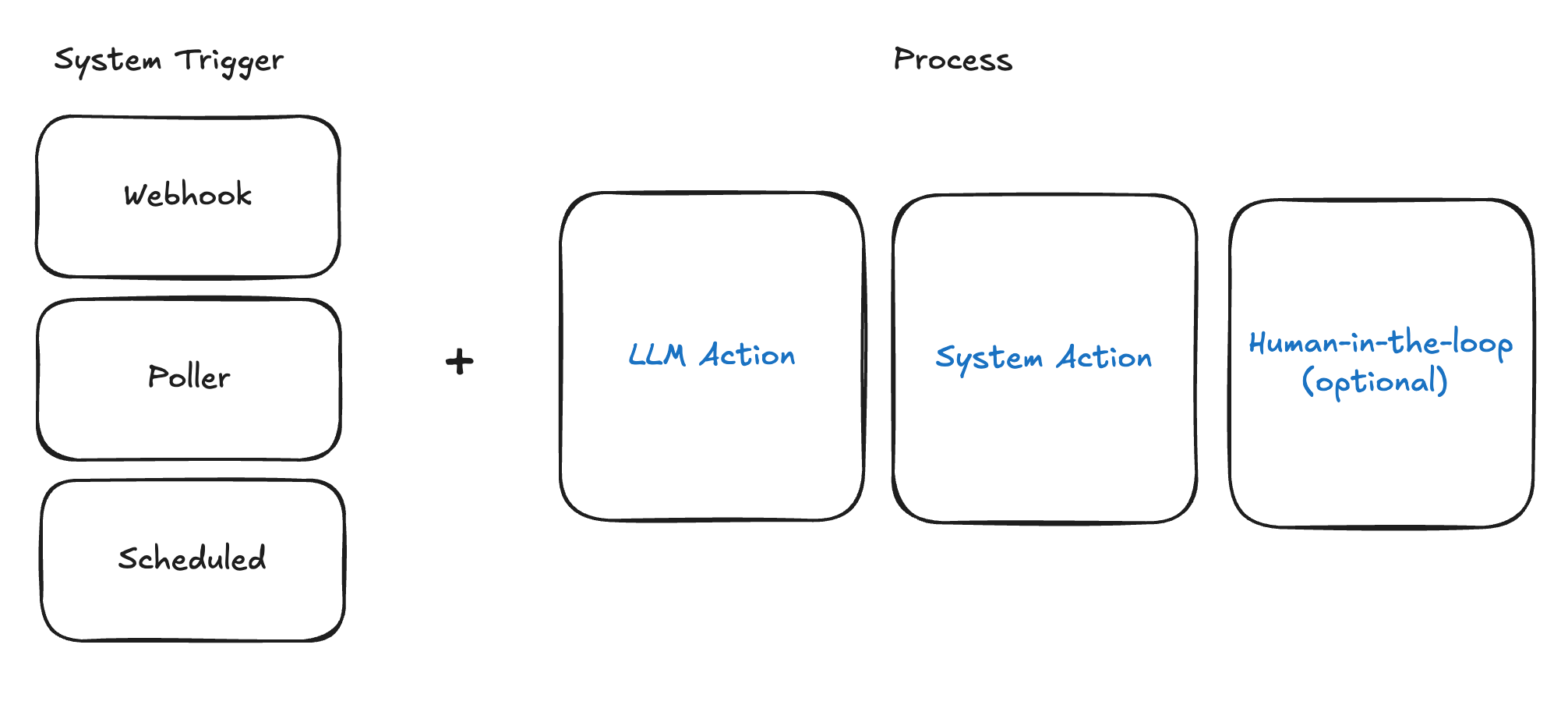
Let’s dive into the components below.
Part 1: System triggers
System triggers are real-time signals emitted by the tools and systems your organization already uses, like Jira, Salesforce, Workday, or ServiceNow — they are the eyes and ears of the proactive enterprise. These signals can represent events, changes, or thresholds that matter. System triggers initiate action automatically and each one serves a different purpose.
| System Trigger | Typical Use | Responsiveness |
|---|---|---|
| Webhooks | React to real-time events (e.g., a new Gong call) | Instantaneous |
| Pollers | Detect system changes (e.g., account health dropping) | Near-real-time |
| Scheduled | Run time-based jobs (e.g., Monday 9 AM checks) | Periodic |
Part 2: Process
If system triggers are the eyes and ears, then the Process is the brain and hands, interpreting signals and determining the path forward. Once triggered, the Ambient agent will evaluate what needs to happen to execute workflows from start to finish. The Ambient agent may choose to:
- Leverage LLM reasoning – make decisions, interpret context, generate or summarize content
- Perform system-level actions – parse files, make API calls, update records, or trigger workflows
- Engage human-in-the-loop oversight (when needed) – route tasks for review or approval when confidence is low or human judgment is required
Together, system triggers and the process form the foundation of Ambient agents.
Check out our AI Agent Marketplace to see 600+ AI agents you can deploy across teams, systems, and workflows.
Example use cases for Ambient agents
Ambient agents can operate with different levels of autonomy depending on the workflow. Some work entirely behind the scenes, while others include key moments for human input and approval. Below, we’ll walk through both types — from fully unsupervised agents to those that include human-in-the-loop supervision.
Customer Health Monitoring (human-in-the-loop)
CSMs risk missing early warning signs buried in dashboards or delayed reports. Ambient agents monitor account health in real time and notify the right owner with context, so teams can engage proactively before issues escalate.
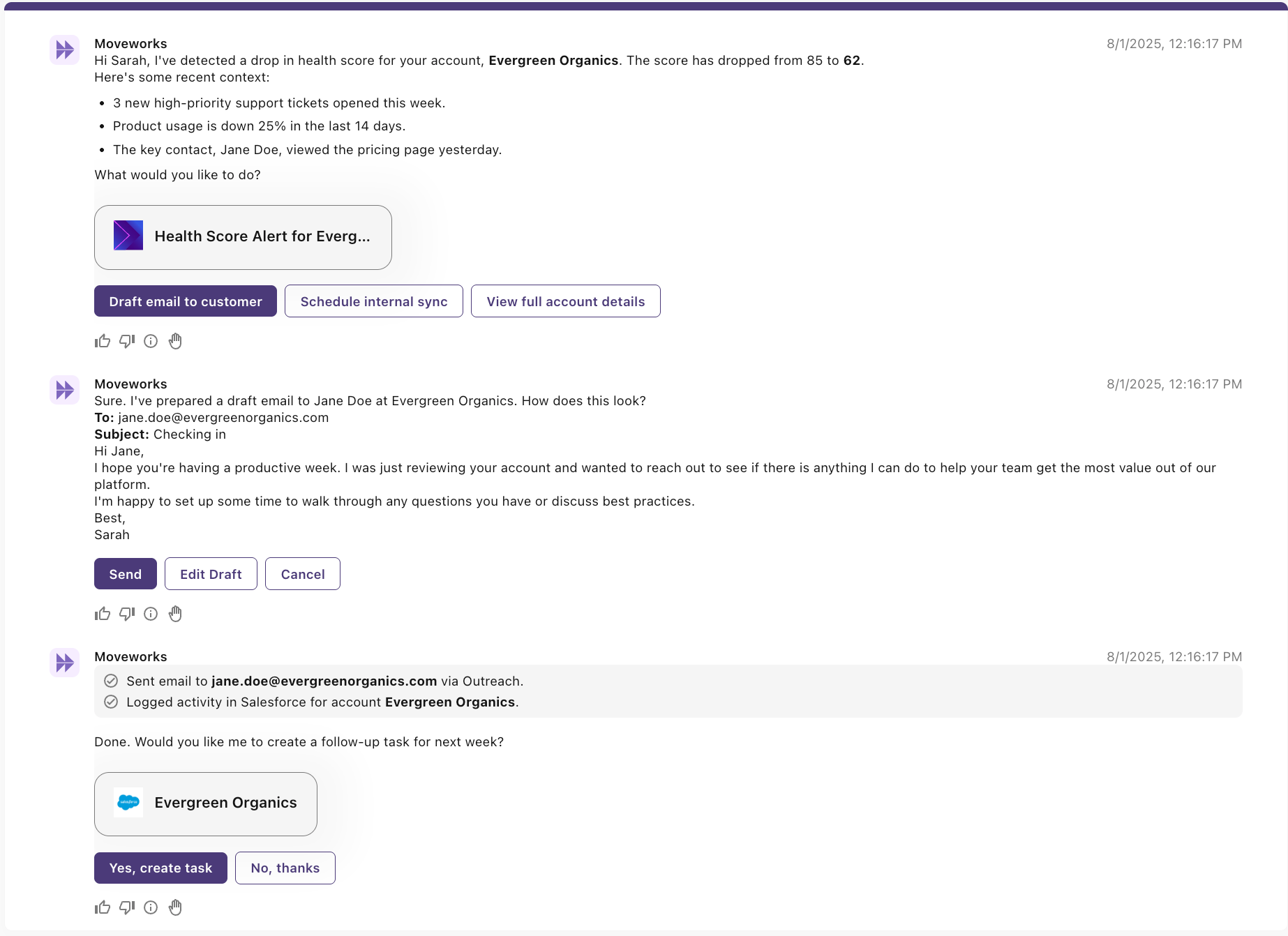
Support Ticket Auto-Triage (unsupervised)
Critical issues often sit idle while support teams work to understand whether it’s urgent and what exactly is broken. Ambient agents can instantly triage new support tickets which involves classifying the issue, checking system status, surfacing related reports, and even attempting to reproduce the problem using internal tools. This allows customer support teams to jump straight into resolution with the full context.
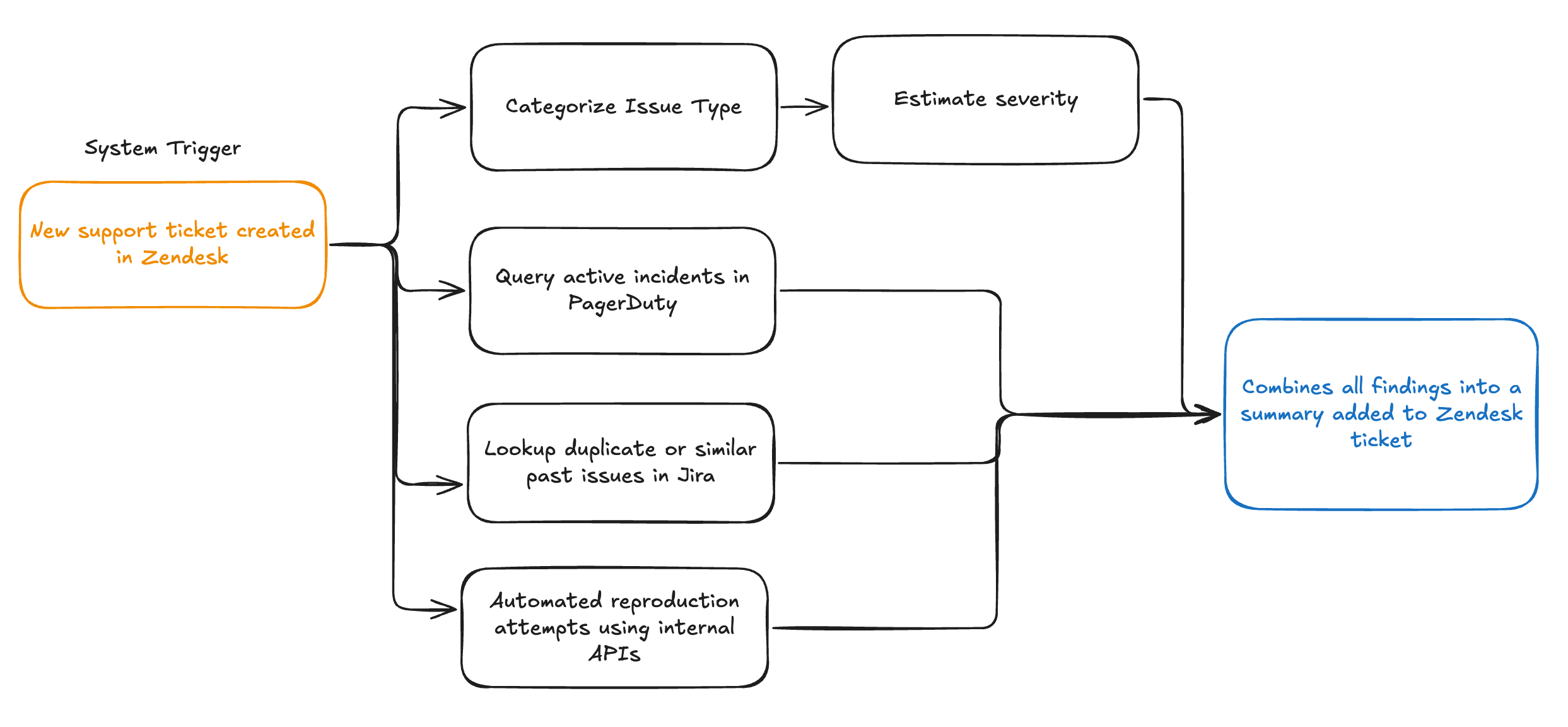
Security Questionnaire Auto-Completion (human-in-the-loop)

Benefits of Ambient agents
Ambient agents do more than automate tasks. They transform how work gets done by acting instantly on system events. Here are the key benefits enterprises are unlocking with Moveworks:
- Accelerate business workflows. Automate entire processes that used to require constant oversight, freeing teams to focus on what matters most.
- Proactive insights to stay ahead. Always-on agents listen for signals across your stack — CRM, ITSM, HRIS, finance — and act before problems surface.
- Trusted with human-in-the-loop supervision. Agents handle backend work and loop in humans only when needed which ensures accuracy, compliance, and confidence.
- Streamlined automation. Built directly on Moveworks, ambient agents eliminate the need for fragmented iPaaS or third-party tools.
One level deeper: The role of human supervision
Even the most intelligent automations need a human touch to learn, especially in high-stakes or ambiguous situations. That’s where the human-in-the-loop approach comes in. Ambient agents are designed to work autonomously, but they know when to pause and pull in an expert opinion. This can happen in a few key moments:
- Notify: Keeping stakeholders informed when actions are taken
- Question: Asking for clarification when context is unclear or confidence is low
- Review: Routing decisions for approval before executing sensitive steps
This blend of automation and human judgment ensures that Ambient agents are not just powerful — they’re also accountable, transparent, and aligned with your business standards. By keeping humans in the loop where it matters most, organizations can scale automation without compromising accuracy or control.
Implementing Ambient agents with Moveworks
Got you thinking about where ambient agents could fit in your org?
The good news: getting started doesn’t require rebuilding your tech stack. With Moveworks, you can go from idea to deployment fast — and scale with confidence.
Start small. Scale fast. Stay in control.
- Identify high-impact opportunities: Start with repetitive, event-driven workflows like license cleanup, ticket triage, or data entry — easy wins that save real time.
- Choose your trigger: Use real-time webhook listeners today. Support for polling and scheduled triggers is landing soon.
- Design your workflow: In Agent Studio, create logic flows by combining LLM reasoning, API calls, and compound actions — all in a low-code environment
- Add guardrails where it counts: Include approvals, notifications, or clarification steps to keep humans in the loop when needed.
- Observe and optimize: Monitor agent performance, refine it, and measure impact using built-in observability tools.
Moveworks makes it easy to bring ambient intelligence to life — on your terms, at your pace.
Ambient agents are a new operating model
Ambient agents aren’t just the next phase of automation, they represent a new operating model for the enterprise. They react instantly, run quietly in the background, and scale effortlessly across teams and systems.
With Moveworks, you can design, deploy, and govern these agents with full confidence, unlocking a future where work moves forward without friction.
In a world where every delay is a missed opportunity, ambient agents give you the ultimate advantage: They act before you ask. Solve before you escalate. Work before you even know there’s work to do.
Interested in building Ambient agents?
Sign-up for our October AI Agent Hackathon to roll-up-your sleeves and deploy cutting-edge Ambient agents.

